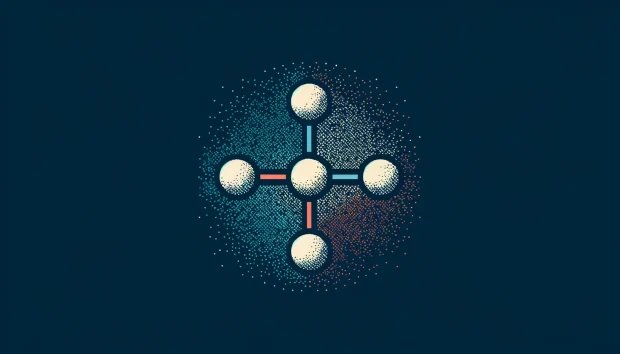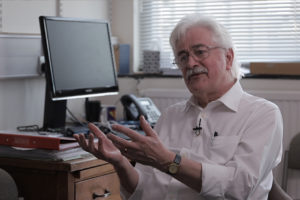Earth’s Magnetospere
Physicist David Southwood on how the magnetic field of Earth causes natural losses of spacecraft, the aurorae ...

On July 15, Nature Physics published a paper “Gating a single-molecule transistor with individual atoms” demonstrating transistor action in a single molecule that is markedly different from the conventionally expected behavior. We have asked one of the authors of this research, Dr. Stefan Fölsch from Paul-Drude-Institut für Festkörperelektronik, to comment on this work.
Transistors, regardless of their size, have a channel region between two external contacts and an electrical gate electrode to modulate the current flow through the channel. In atomic-scale transistors, this current is extremely sensitive to single electrons hopping via discrete energy levels. Single-electron transport in molecular transistors has been previously studied by a number of research teams using top-down approaches, such as lithography and break junctions. But atomically precise control of the gate – which is crucial to transistor action at the smallest size scales – is not possible with these approaches.

In our laboratory at the Paul-Drude-Institut, we used a highly stable scanning tunneling microscope (STM) operated at a temperature of 5 K to build a transistor consisting of a single phthalocyanine molecule and positively charged indium atoms, positioning them with the STM tip on the surface of an indium arsenide (InAs) crystal. Our collaborator Kiyoshi Kanisawa, a physicist at the NTT Basic Research Laboratories in Japan, used the growth technique of molecular beam epitaxy to prepare the InAs surface. Subsequently, the STM approach allowed us to assemble electrical gates from the +1 charged indium atoms with atomic precision and, then, to place the molecule at various desired positions close to the gates. Importantly, the molecule is only weakly bound to the InAs template. For this reason, when we bring the STM tip very close to the molecule and apply a bias voltage to the tip-sample junction, single electrons can tunnel between template and tip by hopping via nearly unperturbed molecular orbitals. This effect is similar to the working principle of a quantum dot gated by an external electrode. In our case, the charged atoms nearby provide the electrostatic gate potential that regulates the electron flow and the charge state of the molecule.
But it turned out that there is a substantial difference between a conventional semiconductor quantum dot – comprising typically hundreds or thousands of atoms – and the present case of a surface-bound molecule: our collaborator Steven Erwin, a physicist at the Naval Research Laboratory in the United States showed, using density-functional theory calculations, that the molecule adopts different rotational orientations, depending on its charge state. His prediction was confirmed by imaging the molecule with the STM. Charge and orientation are thus coupled degrees of freedom, and this has a dramatic effect on the electron flow across the molecule, which is manifested by a large conductance gap at low bias voltages. Our collaborators Felix von Oppen and Piet Brouwer together with their students Elina Locane and Mark Thomas – all physicists at the Freie Universität Berlin working in quantum transport theory – commented that the surprising behavior we observed goes beyond the established picture of charge transport through a gated quantum dot. They then developed a generic model that accounts for the coupled electronic and orientational dynamics of the molecule. This simple and physically transparent model accurately reproduces the experimentally observed single-molecule transistor characteristics.
The proposal of future electronics with organic molecules as device components – put forward as early as 1974 – has stimulated immense research effort aiming at single-molecule function in a solid-state environment. Scanning tunneling microscopy has proven a powerful experimental tool in this respect because it combines imaging and spectroscopic means with the capability to manipulate matter at the atomic scale. The STM technique to manipulate single atoms on a surface was pioneered by Don Eigler’s IBM research team about twenty-five years ago. Since then, it was applied mainly to atoms and molecules adsorbed on metal surfaces. During the past seven years, we extended this approach to surfaces of compound semiconductors – such as InAs.
To explore model cases of single-molecule function in an environment compatible with existing device technologies it is essential to employ semiconductor materials as templates. On semiconductor surfaces with unsaturated dangling bonds, such as Si surfaces, organic molecules are generally chemisorbed or even fragmented upon adsorption. Nevertheless, conductance switching triggered by local electrostatic fields and tunneling electrons was achieved in single molecules linked to Si surfaces. On the other hand, a concept utilizing molecular building blocks with predefined properties that are not quenched, or even significantly perturbed, upon adsorption requires a molecule-semiconductor system characterized by a weak electronic coupling. We found earlier that this can be achieved for planar pi-conjugated molecules such as phthalocyanines bound to the compound semiconductor surface InAs(111)A.
The perfection and reproducibility of the tiny transistors demonstrated here, first created and then investigated by the STM under extremely well-defined conditions at low temperature in ultra-high vacuum, allow us to elucidate the elementary processes involving current flow through single molecules at a fundamental level. Understanding such processes is the basis for a future integration of molecule-based devices with existing semiconductor technologies. Nevertheless, the path from our work to a practical molecular device is still a long one, requiring interdisciplinary input from both science and engineering. The various challenges include, among many others, the issue of applying defined electrical contacts to molecular structures and the requirement of robustness under realistic operational conditions. Exploring the basic physical and chemical properties of highly defined model structures is important to tackle these challenges. At this point, combined experimental and theoretical approaches are crucial to thoroughly understand the physical behavior of a real material system – even when it comes to the seemingly simple case of a single molecule and a few atoms sitting on a surface. Surface science is rarely simple: indeed, Wolfgang Pauli, one of the pioneers of quantum physics, used to say that “the surface was invented by the devil.”

Physicist David Southwood on how the magnetic field of Earth causes natural losses of spacecraft, the aurorae ...

Electrical engineer Xingjie Ni on the 'invisibility cloak', metasurfaces, and nanoantennas that can control li...

Physicist Joanna Haigh on natural temperature records, ocean circulation, and global warming